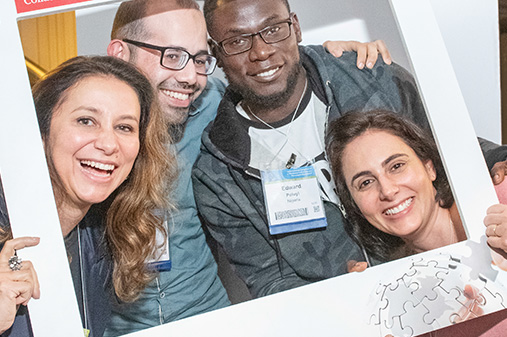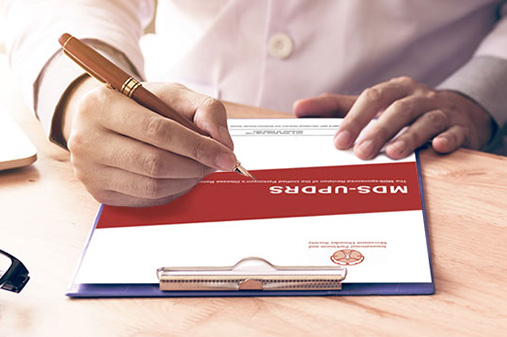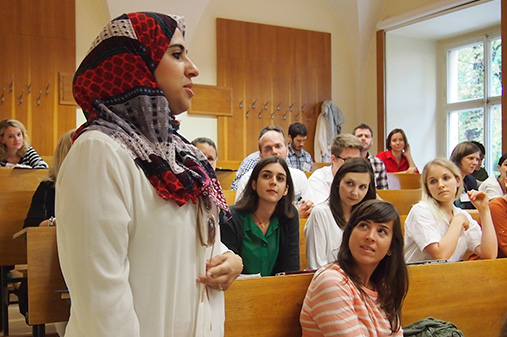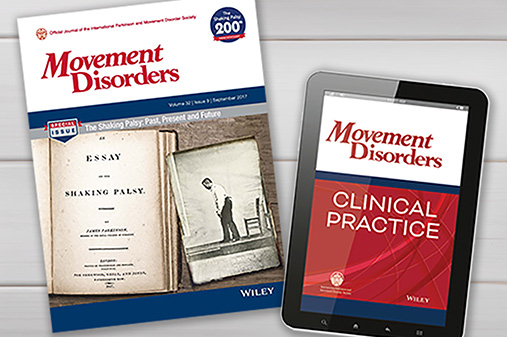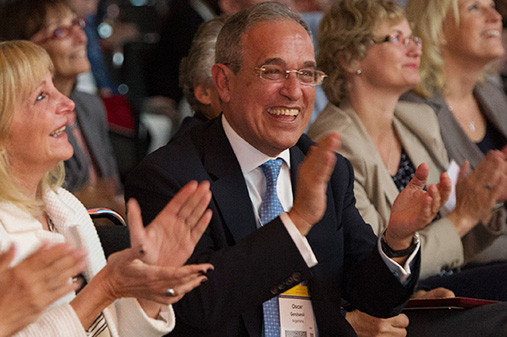Prime editing - A future therapy for cortical myoclonus?
Prof. Marina de Koning-Tijssen: [00:00:00] Hello and welcome to the MDS Podcast, official podcast of the International Parkinson and Movement Disorder Society. Today we're in the sixth and last episode of the Myoclonus Special Series. I'm Marina de Koning-Tijssen neurologist and head of the Expertise Center Movement Disorders in Groningen in the Netherlands.
View complete transcript
Today my guest is Sabine Fuchs, professor of Metabolic Diseases and Innovative Therapies at the University Hospital in Utrecht the Netherlands, to discuss the topic, prime editing a future therapy for cortical myoclonus. Professor Sabine Fuchs is a pediatrician trained in Utrecht where she also specialized in metabolic disorders.
Alongside her clinical work, she has been deeply involved in research and holds a position at the regenerative medicine center Utrecht . Her research focuses on [00:01:00] metabolic diseases broadly with a particular emphasis on developing therapies using new technologies such as precise gene editing to address various diseases.
She also works on personalizing treatments through patients' derived cell and organoids models. Sabine, thank you so much for joining me today and I'm very keen on learning from you. Let's start with the question. What is prime editing?
Prof. Sabine Fuchs: Thank you very much for inviting me here. It's a pleasure to be here. And prime editing is one of the precise gene editing techniques. So it's a technique based on the CRISPR-Cas technology that you might know which is based on very precise cuts in the DNA and with CRISPR-Cas. Originally you made double stranded cuts, so you really completely cut both strands of the DNA and the newer versions. So [00:02:00] base editing and prime editing are versions where they use an inactivated cas enzyme that only cuts open one of the strands of the DNA and that makes it a much safer technology. And then this cas enzyme is fused to another enzyme to change bases in base editing or to rewrite bases in prime editing.
So prime editing is a very versatile and safe, precise gene editing technology that allows you to change numerous bases in the DNA at once.
Prof. Marina de Koning-Tijssen: Okay and you're saying it's a safer technique. What do you mean by that?
Prof. Sabine Fuchs: So when you use the conventional CRISPR-Cas system it makes double-stranded DNA breaks and cells don't like it when their DNA is broken. So they immediately try to repair that. And usually they use non-homologous enjoining, and that's a very imprecise technique in which the DNA is just pasted together.
And that's quite a sloppy technique [00:03:00] where you can insert additional nucleotides or you can delete parts of the DNA and that is considered unsafe or at least not very precise and controllable. And by making only one cut in one of the DNA strands, it's a much safer procedure, so you just edit the DNA that you want to edit in the way you want to edit it.
Prof. Marina de Koning-Tijssen: Okay. And this prime editing, since when is this applied? Is it already used in patients?
Prof. Sabine Fuchs: No, as far as I know, it has never been used in clinical trials so far. We do hear the promise. That for example, prime medicine is about to launch the first trial, and the FDA has approved use in human trials, so it's upcoming. And there are some very promising results in animal models.
Prof. Marina de Koning-Tijssen: Okay. And what kind of disorders is this suitable for? Is it suitable for all genetic disorders? Can you say something about that?
Prof. Sabine Fuchs: Yeah, so [00:04:00] in principle, the technique can be applied to almost any mutation, so that would involve all genetic disorders. But the main obstacle at this moment is to achieve efficient editing in sufficient cells of the organ that you want to edit. And that brings along that there is a subset of diseases that are easier to edit.
So for now, most research focuses on hematopoietic stem cells bone marrow stem cells because you can edit them outside of the body and then give autologous gene corrected cells back through bone marrow transplantation. But you can also target the liver quite efficiently because the techniques to deliver the prime editors to the different organs in vivo they accumulate naturally in the liver.
So the liver, if you have a liver dominant genetic disease, which again, for example treat with a liver transplantation, those are disorders that are [00:05:00] very suited for treatment with gene editing technologies. And the eye is also an organ that is relatively easy to target because you can just approach it locally and you can achieve relatively high doses of the gene editors in a very localized area.
So these are the low hanging fruits or the organs that are first to be targeted. But there is a lot of research going on to try and target other organs like for example, the brain or other parts of the central nervous system, which are particularly interesting for you, I think, but also for a lot of metabolic diseases.
Prof. Marina de Koning-Tijssen: Yes. And because we came in touch. We know each other for quite a while, but we came in touch according to research when you joined the meeting where we discussed the GOSR2, the North Sea Epileptic progressive myoclonus epilepsy. And then you said I'm keen on trying, if I can do something for this group.
[00:06:00] Can you say something about that?
Prof. Sabine Fuchs: Yes, it was a very impressive meeting I thought, where there was also a mother who told about her child who was deteriorating, but at a slow rate. And the intellectual function of this patient was relatively preserved. And there's another very important thing is that almost all patients carry the same mutation either in homozygous or heterozygous form.
But that means that if we would make a treatment for this one mutation, we could treat the whole Dutch population that is affected with this disease. So that is why I thought there was a cry of despair from this mother. We have to do something for our patients. And I thought we can at least give it a try.
Prof. Marina de Koning-Tijssen: Yes. And that resulted in funding possibilities. So that was good. But by saying that how hard is it to get it through the blood brain barrier? How do you see that? Can you say something about that?
Prof. Sabine Fuchs: Yeah, so [00:07:00] there are various obstacles that we have to take. So first of all, you have to correct the mutation in vitro. So that is the first step. And I thought when doing our first experiments with prime editing, that we could edit almost any mutation with high efficiency. But now that we're more and more working on this, I do realize that some mutations are easier to correct than others.
But there is a lot of technological progress there as well. So I think in the end that will not be the major hurdle, but that is something we're working on now to try and correct it as efficiently in the lab as we can and also as precisely as we can. But then the next hurdle is to get it into the brain cells in sufficient concentrations and also in the correct brain cells.
Passing the blood brain barrier is of course one of the hurdles that we may face on the other hand because we think it is a once only treatment. So a treatment you only have to give once. I could imagine that we can also [00:08:00] inject the therapy, for example intrathecally, so in the cerebrospinal fluid directly so that we don't have to pass the blood-brain barrier using our delivery strategy.
Prof. Marina de Koning-Tijssen: Okay, so what you're saying I think is important. Is that you just have to do it once.
Prof. Sabine Fuchs: That's what we expect now. We really correct the DNA. So it's once that is corrected, it will not revert or change backwards. And it will be given to the other cells. So it's something, once it is achieved, it is there to stay.
Prof. Marina de Koning-Tijssen: Okay. Can you say something about risk, because it also sounds a bit scary that you say you once have to change and then it'll happen. Is there something known about possible risks of those therapies?
Prof. Sabine Fuchs: So the strategy we employ to deliver the gene editors, that's currently what we're mostly exploring is to give the gene editor as mRNA encapsulated in lipid [00:09:00] nanoparticles. So that is the technique that was used, for example, in the covid vaccines, and those have been applied. All over the world and have been shown to be safe.
So the delivery technique seems to be safe and the strategy that we use as mRNA means that the prime editor will only be active for a short time because mRNA is degraded and the protein, once it's produced, will be degraded after hours or days as well. So that means you don't have an active prime editor in your body for the rest of your life, which would scare me at least.
And so that's one of the strategies. The other strategy is also a transient delivery system where you give the prime editor directly as a protein in particles. So that is also a short expression. That means that the delivery methods, I think, per say are pretty safe. Then there's a point of gene editing, of course, which makes permanent changes in the DNA.
And if you only do what you want to do, [00:10:00] then I guess it's safe, but you're always at a risk to also insert changes that you don't want to change. So there are two types of unwanted effects you can have on target, unwanted effects, side effects. So that happens a lot with base editing, for example, because that's just a base editor can change a certain base, but it will change all the bases within the editing window.
And those are sometimes the basis that you don't want to edit as well. For prime editing, it's more precise in that sense that you transcribe the transcript. That you integrate in the DNA. Although it has been reported that sometimes you also at the end of the reverse transcriptase templates you can add one or two or more of the nucleotides that you don't want to integrate in the DNA.
These percentages are very low, but we still have to investigate if it's low enough to be safe to apply this in vivo directly. And then there's [00:11:00] off-target results. So far, we've done a very broad mutational analysis with whole genome sequencing to see if there are specific patterns that we find in the genome after gene editing.
And we haven't found any specific mutational signature so far. But of course. That's a limited set of data. So we have tested in quite a number of prime edited cells, but you're never completely sure that it won't happen in another cell.
So that has to be seen really in clinical trials, how safe it is.
Prof. Marina de Koning-Tijssen: And is there a route to start a clinical trial, you said there was one, right? But not from your lab, but there you had the idea. There was one starting.
Prof. Sabine Fuchs: Yes, so with base editing, there have been some clinical trials and some clinical good effects. Also using this, these short term delivery strategies. So even in the Netherlands, there's one patient with hereditary angioedema who has been treated in Amsterdam. With base editing given as mRNA in [00:12:00] lipid nanoparticles in the liver.
And that has been very successful and safe so far. So that's very encouraging, I think for prime editing. Prime Medicine, which is the company founded by David Liu, who is the inventor of prime editing in Harvard and MIT. They have presented results at conferences where they're doing already the trials in non-human primates which were very successful.
So I think they're about to launch a clinical trial, but I don't know exactly when.
Prof. Marina de Koning-Tijssen: Okay. And coming back to the progressive myoclonus epilepsy or ataxia with the Gosar two mutation. I understood well that it helps a lot, that there is like a founding mutation that all the patients have the same, otherwise you have to do it for each of the mutations again, like in a personalized way.
Prof. Sabine Fuchs: Yes, so I see it as a platform technology. So a lot of the elements can be used for any treatment. So the prime [00:13:00] editor, the delivery vehicles, that is all the same for everyone. Only the very specific guide, RNA, that guides you to the exact mutation and also includes the reverse transcriptase template to encode the exact sequence of DNA that you want to introduce. These have to be adapted to each and every different mutation.
Prof. Marina de Koning-Tijssen: Okay. And well, as we are talking about in the Movement Disorder Society, there are definitely other disorders as well, but I'm very involved in myoclonic disorders, especially this, cortical myoclonus, like in GOSR2. But, when I hear you well, you expect that this might be also effective in other genetic cortical myoclonus.
Is that right?
Prof. Sabine Fuchs: Absolutely.
Prof. Marina de Koning-Tijssen: Yeah. So it's really a very exciting period. And when do you, and this, I know this is a very tough question, but what do you expect about the timeline of this? With the cortical [00:14:00] myoclonus in GOSR2.
Prof. Sabine Fuchs: Yeah I'm always very reluctant to name a year because I've experienced in research that sometimes things go much faster than you had expected, but more often things go more slowly than you had wanted or expected. But I do think that the progress in the genetic technologies is unprecedented.
Right now, there is an enormous amount of research in the field of delivery as well. We can deliver also genetic therapies through viral vectors. I'm not so fond of that for the gene editing technologies, because then you have a constitutively active gene editor in your body. But these are ways to maybe try these therapies at least in animal models and test them. I think we'll be pretty fast for the first three organs that I named. So for the bone marrow, for the liver, and for the eye, I foresee the first clinical trials in the coming [00:15:00] two, three years. The brain or other parts of the central nervous system. I assume that will take longer. But I hope to be there in 5 to 10 years.
Prof. Marina de Koning-Tijssen: Okay. That still sounds very exciting, right? And we have to be patient because we must have the right, way to use it, right? So if it takes 10 years, it's still very exciting and something to look forward to. just one final question. Are there ethical issues around this editing of the genes?
Do you come across that or can you say something about that?
Prof. Sabine Fuchs: I think that any new technology, which may have so much influence in the end comes with ethical discussions. So I think, of course there are ethical issues not only pertaining to, are we allowed to change the DNA? Can we hack evolution? But also to what patients should we [00:16:00] treat?
When can we make the bench from bed to bedside? How do we allow for. Well, for example for fair funding of these therapies and how can we involve as many patients as possible and not only rich patients that by chance visit our hospital.
Prof. Marina de Koning-Tijssen: Yeah.
Prof. Sabine Fuchs: So there are a lot of ethical issues, I think, and we do perform parallel ethical research while developing these therapies because I think it's extremely important to do this in a morally sound manner.
Prof. Marina de Koning-Tijssen: Sabine, thank you so much for giving us so much insight in this new prime editing. I think it's very excited and it clarified a lot for me and I also hope for the people listening to the podcast. So I would thank you so much and I think we are coming now to the end of the last episode of the MDS special series on myoclonus and I think this is a very hopeful end where we hope well with [00:17:00] your words in 10 years, we might have made a big step forward. Thank you so much.
Prof. Sabine Fuchs: Thank you very much. It was a pleasure.

Sabine Fuchs, MD, PhD
UMC Utrecht
Utrecht, Netherlands

